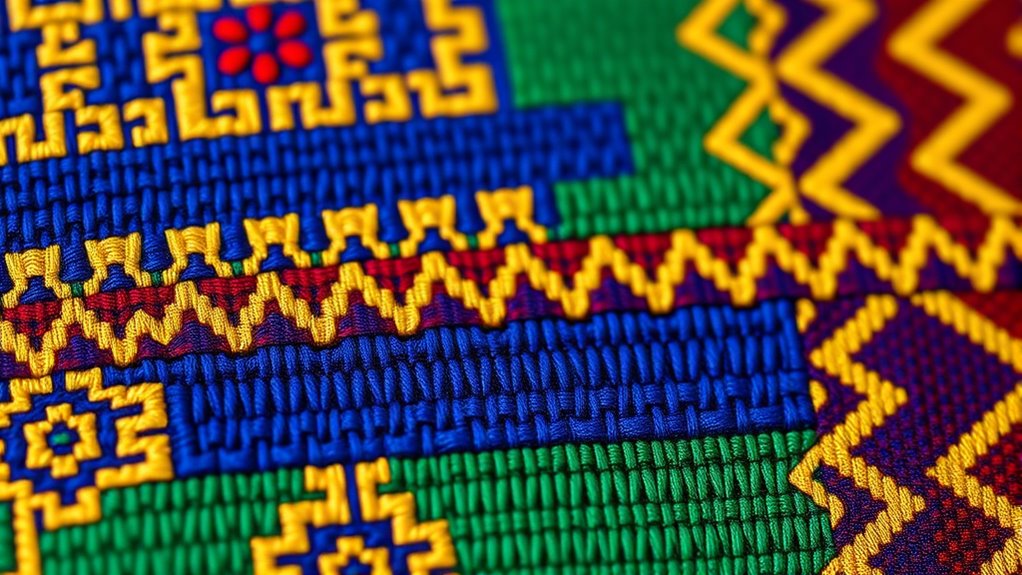Ghana’s Kente cloth is full of symbols and colors that tell stories about identity, history, and social values. Each pattern and hue has deliberate meanings—like gold for wealth, red for strength, and geometric shapes for wisdom or unity. The intricate weaving process and designs connect you to Ghana’s rich culture, honoring ancestors and traditions. If you look closer, you’ll see how every detail reveals a deeper story woven into this vibrant fabric.
Key Takeaways
- Kente patterns use geometric symbols that convey messages about wisdom, unity, strength, and societal values.
- Colors in Kente have specific meanings, such as gold for wealth and red for spiritual strength.
- Designs are deliberate, with each pattern telling a story or representing cultural beliefs and traditions.
- Patterns and colors serve as a visual language, communicating social status, history, and cultural identity.
- Woven symbols connect generations, preserving heritage and celebrating individual and communal pride.

Ghana’s Kente cloth is a vibrant and intricate textile that embodies the rich cultural heritage of the Akan people. When you see Kente, you’re witnessing more than just colorful fabric; you’re observing a symbol of identity, history, and social status. Each pattern and color carries deep meanings, making the cloth a powerful form of communication. The cultural significance of Kente stretches back centuries, traditionally reserved for royalty, important ceremonies, and special occasions. Wearing Kente signifies respect, honor, and a connection to your roots. It’s not merely fabric but a tapestry of stories woven into every thread.
You might wonder how these stunning patterns come to life. The weaving techniques used in creating Kente are highly specialized and passed down through generations. Using narrow strips of silk or cotton, skilled artisans carefully weave the cloth on a loom, often by hand. This process requires precision and patience, as each strip is woven with specific patterns that form the complete design. When you observe a Kente cloth, you’re seeing the result of centuries of craftsmanship, where every step is deliberate, and every pattern holds meaning. The weaving techniques create a textured, layered effect that enhances the visual complexity of each piece. The process also involves a meticulous selection of colors, each representing different concepts like royalty, fertility, or spiritual beliefs.
The intricate weaving of Kente reveals centuries of craftsmanship and rich cultural symbolism.
As you study a piece of Kente, you’ll notice how the patterns are not random—they are deliberate symbols. For example, certain geometric shapes might symbolize wisdom, unity, or strength. The colors further deepen this symbolism: gold indicates wealth and status, while red symbolizes political and spiritual strength. The weaving techniques allow these symbols to be woven seamlessly into the fabric, making each piece a narrative that reflects cultural values and societal roles. It’s essential to understand that Kente isn’t just about aesthetics; it’s about conveying messages and affirming cultural identity. When you wear or gift Kente, you’re participating in a tradition that celebrates history, honors ancestors, and expresses individual and communal pride.
In essence, Kente’s beauty is rooted in its cultural significance and the weaving techniques that bring it to life. Each pattern is a visual language, telling stories that connect generations and preserve Ghanaian heritage. When you wear or admire Kente, you’re engaging with a tradition that’s as meaningful as it is visually stunning.
Frequently Asked Questions
How Are Kente Patterns Traditionally Passed Down Through Generations?
You learn that kente patterns are traditionally passed down through generations as a essential part of cultural heritage. Elders teach younger family members the meanings and significance behind each design, preserving ancestral knowledge. You might see this happen during special ceremonies or family gatherings, where stories and symbolism are shared. This process keeps the cultural traditions alive, ensuring that the intricate patterns and their meanings remain meaningful and relevant for future generations.
What Are the Modern Adaptations of Kente Cloth Design?
You see modern adaptations of kente cloth through digital innovation, which allows designers to experiment with new patterns and vibrant colors, making the designs more accessible worldwide. Additionally, eco-friendly textiles are increasingly incorporated, ensuring sustainable production. These innovations help preserve the cultural significance while updating the craft for contemporary tastes, making kente more versatile and environmentally conscious without losing its traditional essence.
How Does Kente Cloth Influence Contemporary Ghanaian Fashion?
You see that Kente cloth greatly influences contemporary Ghanaian fashion by blending cultural identity with fashion innovation. When you wear Kente-inspired designs, you showcase traditional symbols in modern styles, making a bold statement. This fusion helps preserve Ghanaian heritage while embracing new trends, inspiring designers and wearers alike to celebrate their roots creatively. Kente’s vibrant patterns continue to shape local fashion, empowering you to express pride and cultural richness confidently.
Are There Specific Occasions When Certain Kente Patterns Are Worn?
You’ll notice that specific Kente patterns are reserved for ceremonial occasions, reflecting their cultural significance. Wearing particular patterns during weddings, funerals, or celebrations shows respect and honor for tradition. These patterns symbolize different values, statuses, or achievements, so choosing the right one aligns with the occasion’s importance. By understanding these customs, you actively participate in preserving Ghanaian heritage and showing appreciation for the rich symbolism woven into each Kente design.
What Materials Are Used in Authentic Kente Weaving Today?
You might be surprised to learn that today, authentic kente often features a blend of traditional and modern materials. While pure silk and cotton still shine, some weavers incorporate synthetic fibers for durability. They also use eco-friendly dyes to protect the environment and preserve the vibrant colors. This combination guarantees that each piece remains beautiful, meaningful, and sustainable, honoring tradition while embracing contemporary practices.
Conclusion
Think of Kente cloth as a vibrant tapestry of Ghana’s soul, where each pattern and color tells a story woven into the fabric of history. As you wear or admire it, you carry a piece of Ghana’s rich heritage, like a living book of symbols and traditions. Remember, every thread is a word, every pattern a chapter, and together they create a masterpiece that speaks across generations. So, embrace the beauty and meaning behind each woven story.










